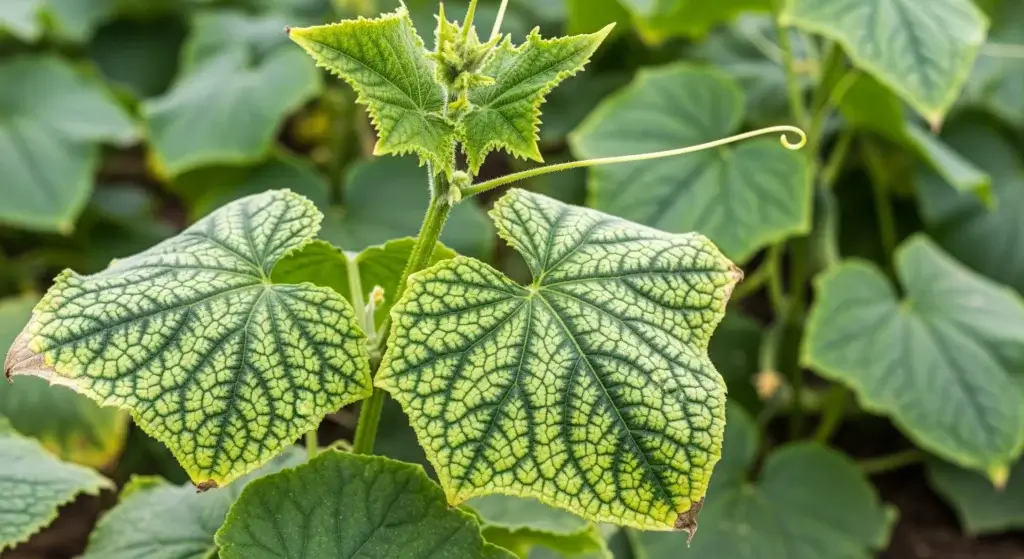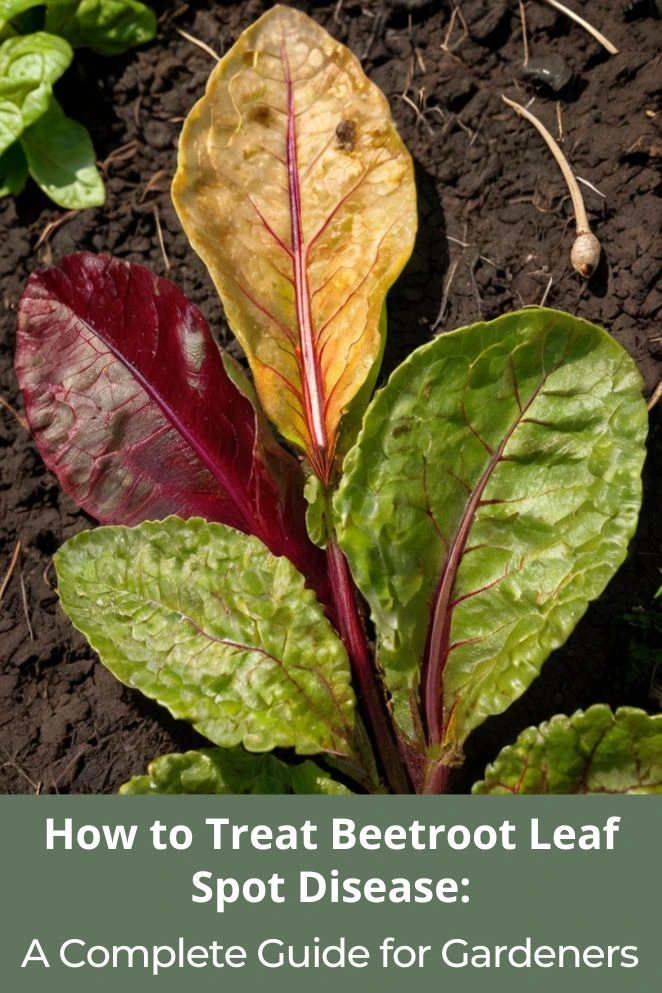
Leaf spot disease hits beet plants hard—killing leaves, wrecking yields, and messing with your harvest.
Whether you grow beets in your backyard or on a big farm, you need to know how to spot it early, treat it fast, and keep it from coming back.
This quick guide breaks it all down so you can protect your plants and get the most out of your crop.
Understanding Beetroot Leaf Spot Disease
Beetroot leaf spot—aka Cercospora leaf spot (CLS)—is a fungal disease caused by Cercospora beticola.
It doesn’t just target beetroot. It also hits your Swiss chard, spinach, and sugar beets.
The fungus loves warm, humid weather and spreads fast if you ignore it.
Identifying the symptoms
Early detection is key to successful treatment. Here are the primary symptoms to watch for:
Early signs:
- Tiny brown circles with light centers on older leaves
- Spots are small—2–5 mm
- Reddish-purple edges around the spots
- Centers turn gray or tan with black dots (those are spores)
Later symptoms:
- Spots grow and connect, making big brown patches
- Leaves go yellow and die
- Lower leaves drop early
- Plants get stunted, roots stop growing
- In bad cases, all leaves fall off
When your plants are most at risk?
Understanding when your beetroot plants are most vulnerable helps with prevention and treatment timing:
- Temperature: Optimal fungal growth occurs between 75-85°F (24-29°C)
- Humidity: High humidity levels above 80% create ideal conditions
- Moisture: Extended leaf wetness periods, especially at night
- Air circulation: Poor airflow around plants increases disease risk
- Season: Late summer conditions are typically most favorable for disease development

Prevention Strategies: Your First Line of Defense
The best way to fight leaf spot? Don’t let it show up in the first place.
Here’s how to build a beetroot defense system using smart, low-tech tricks that work with nature.
Rotate your crops
Don’t grow beets—or anything in the same family like chard or spinach—in the same spot every year.
Rotate crops every 2–3 years.
That gives the fungus less chance to stick around in the soil and surprise you next season.
Give your beets some space
Beets need room to breathe. Don’t cram them in like it’s rush hour.
Good spacing = better airflow = faster drying after rain or watering.
Less moisture means less fungus. Simple.
Water smart, not sloppy
Moist leaves are a fungal rave. Don’t give them the vibe.
- Water at the base, not from above
- Use drip lines or soaker hoses—no splash zone
- Water early in the morning so leaves dry off during the day
- Never water at night (wet leaves + darkness = fungus fiesta)
Keep it clean
A messy garden is a leaf spot magnet. Keep it clean:
- Pull and toss infected leaves ASAP—don’t compost them
- Wipe down tools between plants so you’re not spreading spores like a leaf spot Uber
- Get rid of weeds—they can carry the same fungus
- Do a deep clean in fall (aka tilling) to bury any leftovers
Pick the right varieties
Some beet varieties handle leaf spot better than others.
They’re not totally immune, but they won’t fold as fast when fungus hits.
Check local seed catalogs or ag extensions to see what grows strong in your area.
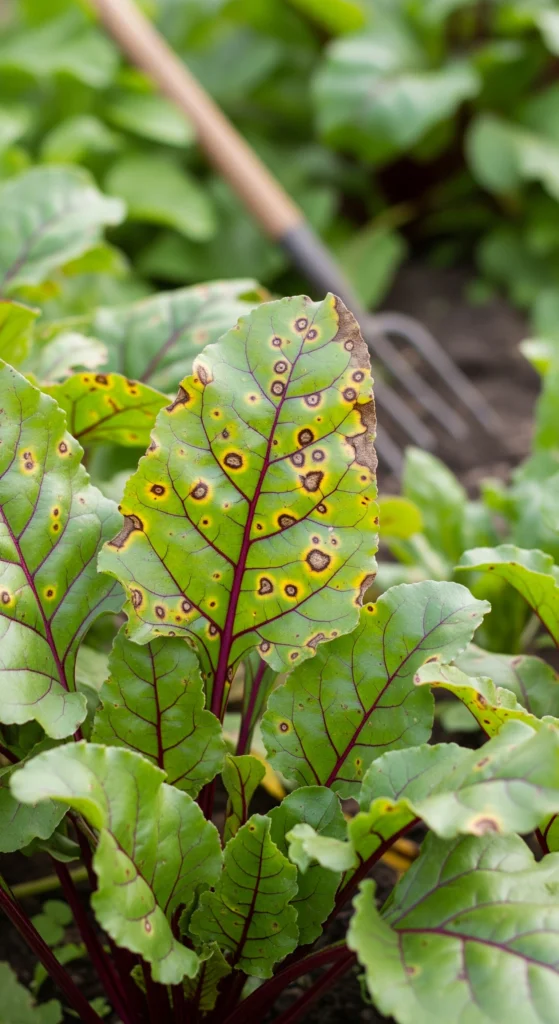
Treatment Options: Effective Solutions for Active Infections
If leaf spot shows up anyway—don’t panic. You’ve got options.
From friendly bacteria to high-tech sprays, here’s how to hit back hard and protect your beets.
Organic treatment methods
Biological controls
Some bacteria are garden heroes. Spray them on your plants and they fight the fungus for you.
- Bacillus subtilis – Stops the fungus from growing. Comes in spray form.
- Bacillus amyloliquefaciens – Found in products like Double Nickel LC. Great for controlling leaf spot.
- Bacillus mycoides – Look for it in LifeGard. Best when used before your plants get sick.
Copper-based fungicides
Copper = old-school fungus fighter. Organic-approved, but go easy—too much can harm good microbes.
- Copper octanoate (Cueva): Works better when used with other treatments.
- Copper hydroxide: Solid choice for active infections.
- Copper oxychloride: Best if you use it early—before symptoms show.
Natural fungicides
- Potassium bicarbonate (MilStop SP): Stops spores from germinating. Use it as a spray.
- Sulfur sprays: Hit weekly as soon as you see spots.
- Neem oil: Helps a bit, but don’t expect it to do all the heavy lifting. Good in combos.
Conventional fungicides
Sometimes, you gotta go full science mode.
These chemical options work well—but rotate them so the fungus doesn’t build resistance.
Systemic fungicides
- Propiconazole (Tilt): Strong and goes deep into plant tissue. Very effective.
- Miravis Prime (Pydiflumetofen + fludioxonil): New combo, crushing leaf spot in trials.
- Benzovindiflupyr + difenoconazole: Heavy hitter. Can reduce disease by up to 97%. Yeah, really.
Combination treatments
- Tank mix: Combine copper + bio treatments for a one-two punch.
- Rotate modes: Don’t use the same thing over and over. Switch it up to prevent resistance.
- Timing matters: Spray when disease pressure is high—especially after warm, humid nights.
Cutting-edge stuff: Nanotech
Yeah, this is real. Researchers are testing tiny particles to block disease better and faster.
- Zinc oxide nanoparticles: Kills fungus, helps the plant too.
- Silicon dioxide: Helps strengthen plant defenses.
- Manganese dioxide: Adds a bonus boost to plant health while stopping the disease.
Application Timing and Techniques
Timing is everything when fighting beetroot leaf spot.
Spray too late or during bad weather, and you’re just giving the fungus a free pass.
Here’s how to get your timing and technique right so your treatments actually work.
When to apply treatments
Preventive sprays (before you see spots)
- Start before the fungus shows up—especially when it’s hot, humid, or stormy.
- Spray during rapid leaf growth—that’s when the plant’s most vulnerable.
- Think of this as putting up an umbrella before it rains.
Curative sprays (when you spot trouble)
- See those first spots? Spray immediately. Don’t wait a day.
- If symptoms stick around, spray again in 3–4 weeks.
- Keep treating until the weather shifts and the fungus can’t thrive anymore (like in dry, cool conditions).
How to apply the spray
Foliar spray 101
- Use a fine nozzle so your spray sticks and spreads evenly.
- Cover both sides of every leaf—top and bottom. Fungus doesn’t care which side it lands on.
- Spray in the early morning or late evening. That’s when the leaves are cool and you avoid sunburn.
Timing matters
- Skip spraying during hot afternoons or direct sunlight—your leaves can scorch.
- Don’t spray if rain’s coming in the next 4–6 hours. It’ll wash off all your hard work.
- Watch the wind. Too breezy? You’ll miss your target and waste product.
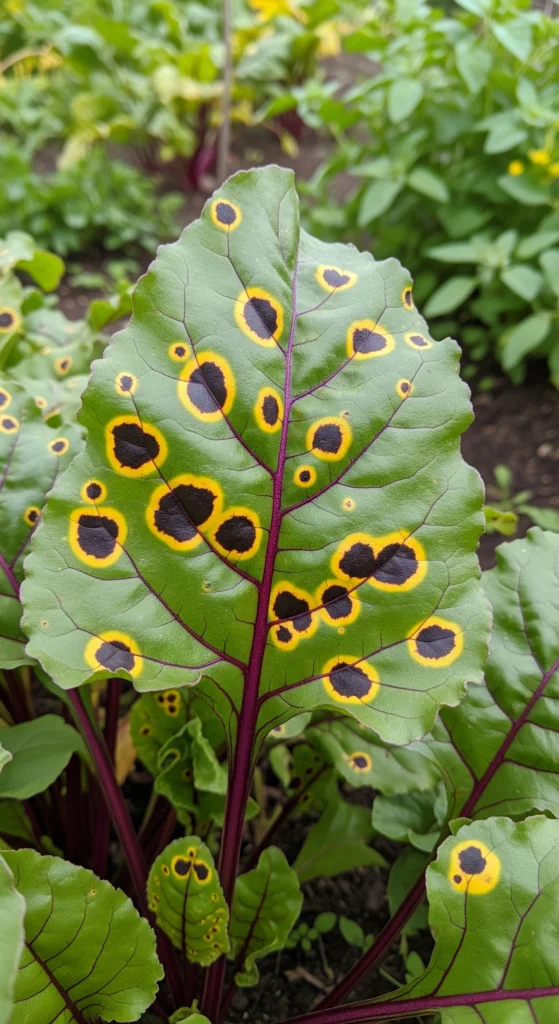
Integrated Disease Management Strategy
No single trick will stop beet leaf spot on its own. You’ve gotta stack your defenses—like building a layered boss fight plan.
Here’s how to mix prevention, treatment, and timing so the fungus doesn’t stand a chance.
Combine your tactics
The best way to control leaf spot? Use all your tools together:
- Start with solid garden habits—like crop rotation, good spacing, and smart watering.
- Use resistant varieties when you can find them. They’re not perfect, but they’ll slow the spread.
- Add biological controls—stuff like Bacillus subtilis to keep fungus in check.
- Use chemical treatments only when things get bad, or when the weather screams “fungus party.”
- Track weather and growth stages so you know exactly when to act.
Seasonal management calendar
Spring (planting season)
- Choose beet varieties that can handle disease better.
- Prep your soil so it drains well—no soggy messes.
- Set up drip lines or soaker hoses. No overhead watering drama later.
Summer (growing season)
- Watch the weather—humid and warm? Time to act.
- Spray preventively during risky weeks (don’t wait for the first leaf to spot).
- Thin your plants if they get too crowded. Let that airflow in—fungus hates dry leaves.
Fall (harvest and cleanup)
- Yank out infected plants and trash the debris (don’t compost it).
- Till the soil to bury leftover spores.
- Plan next year’s crop rotation—no beets in the same spot.
Common Mistakes to Avoid
Even experienced gardeners slip up when dealing with leaf spot.
But if you know what to avoid, you’re already one step ahead.
Here’s a breakdown of the most common screw-ups—and how to dodge them like a pro.
Treatment mistakes
Waiting too long
If you wait until your leaves look like they’ve been polka-dotted with fungus, it’s already a mess.
Start treatments early—before symptoms show if you know conditions are right for disease.
Using the same fungicide over and over
Fungus is sneaky. Use the same mode of action too often, and it builds resistance like it’s training for a boss fight.
Rotate your fungicides so the fungus doesn’t learn your moves.
Bad spray coverage
If you don’t cover both sides of every leaf, you’re just doing plant perfume, not protection.
Fungus loves hiding underneath. Use a fine mist sprayer and hit every angle.
Bad timing
Spraying in the heat of the day or right before rain = wasted effort. S
pray early morning or late evening, and only if the weather looks clear for a few hours.
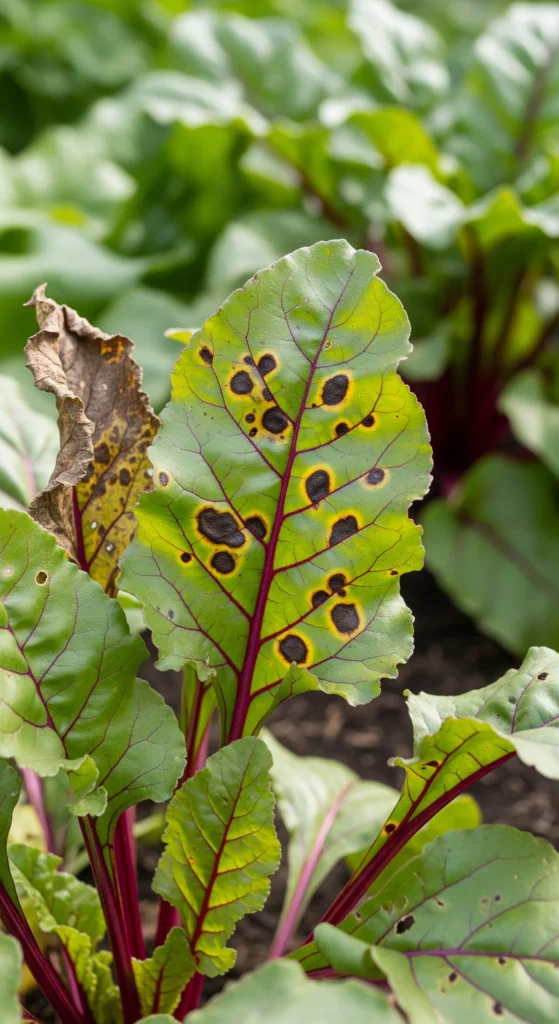
Cultural Practice Mistakes
Watering from above during humid weather
This one’s a classic mistake. Overhead watering = wet leaves = fungus happy hour.
Stick to drip or soaker hoses, and always water early so leaves dry fast.
Crowding your plants
Beets need space to breathe. Jam them in too tight, and airflow disappears.
Moisture sticks around longer, and that’s leaf spot heaven. Thin them out.
Skipping crop rotation
Growing beets (or their cousins) in the same spot every year? That’s just giving the fungus a comfy home.
Rotate every 2–3 years. No exceptions.
Messy garden = fungus playground
Dead leaves, leftover plants, dirty tools—these all help the fungus spread.
Clean up as you go. Sanitize tools. Don’t leave infected stuff lying around like you’re growing spores on purpose.
Final Take: Beat Leaf Spot Before It Beats Your Beets
Keeping beetroot leaf spot in check means doing a little of everything—smart prevention, early spotting, and fast treatment.
Use resistant varieties, follow solid garden habits, and spray only when you need to.
Prevention is cheaper and easier than fixing a full-blown outbreak.
So, stay alert, act early, and keep your beet patch clean and spaced out.
Know your local conditions, stay consistent, and adjust your game plan as needed.
Whether you’re growing a few beets or managing a whole farm, these strategies help you protect your plants and get that sweet harvest.

